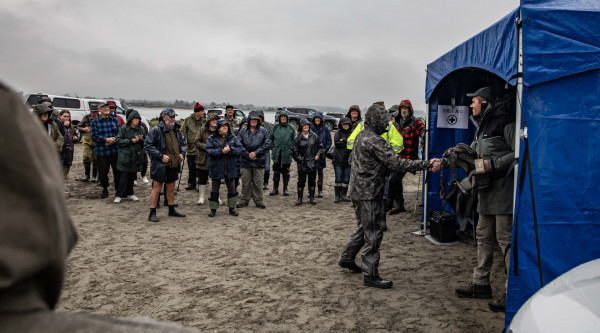Weekly fishing report for Central South Island and North Canterbury 4 April 2024
- 4/04/2024
- Richie Cosgrove
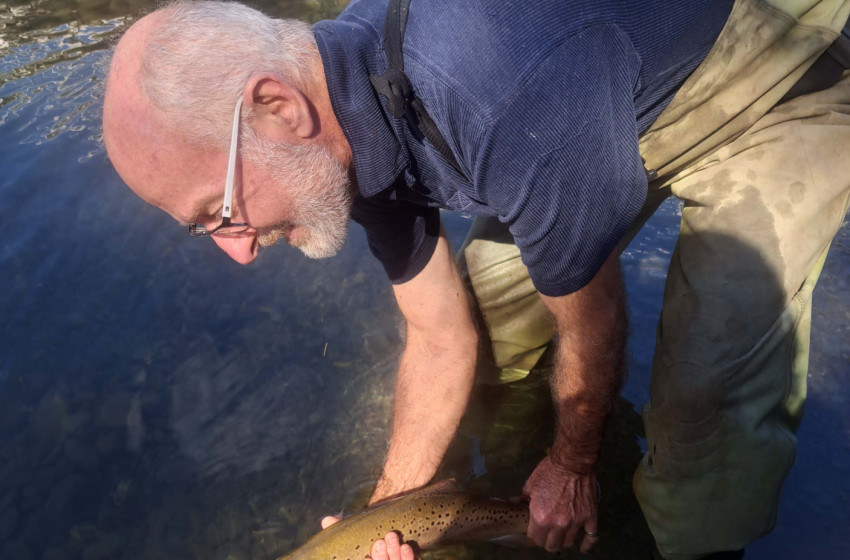
CENTRAL SOUTH ISLAND REPORT
Volunteers helps to save residents of Dobies Stream
Above: Bruce from Mia Flora in Winchester helps to release a brown trout relocated from a section Dobies Stream last week - photo Nikki Dellaway
When Mia Flora proprietor Bruce, pictured above, heard that I was working alone one afternoon in Dobies Stream to salvage stranded fish he wasted no time pulling on his waders, grabbing a net and a bucket and mucked in to give me a hand for a couple of hours.
Bruce’s café and garden centre overlooks Dobies Stream and he has been watching the flows ebb to nothing over the last month.
Bruce said he has grown quite attached to the fish over this time and found it very rewarding to be a part of the liberation process. We certainly appreciate his help and enthusiasm.
CSI Fish and Game Officers successfully salvaged 83 brown trout of varying ages, along with many native fish including two lamprey from Dobies Stream in March.
These were all released to the nearest permanent water within the catchment.
If you report a fish stranding to Fish & Game there are some key pieces of information we need to know to triage the urgency to attend versus other important work at hand.
Please tell us,
- Exact location.
- How many live fish, their sizes, and species.
- How deep the water is in the pools - we can only efficiently recover fish using electric fishing in shin-deep water or less.
- Is there water flowing into the pool where they are stranded.
You can contact us at our Temuka Office, phone - 03 615 8400 or email [email protected]
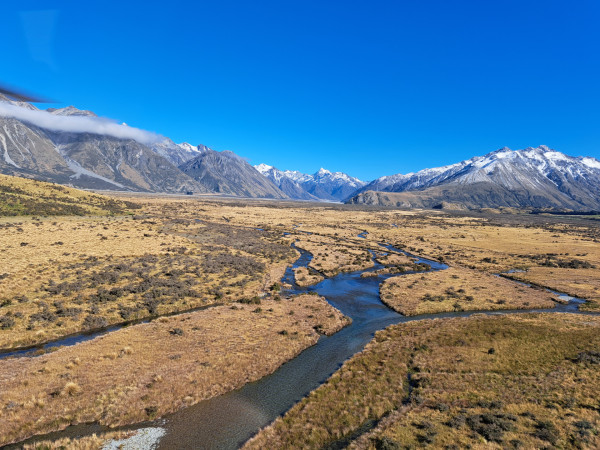
The uppermost sections of Deep Creek, a key spawning site for Rakitata sea-run salmon – Photo by Hamish Stevens
First of the sea-run salmon spawning counts complete
CSI Fish and Game Officer Hamish Stevens completed the first of the sea-run salmon spawning counts for the season last week.
76 sea-run salmon were observed in the Upper Rangitata/Rakitata spawning streams.
Hamish says it’s too early to determine the spawning population from a single count and four further counts will be required before the full picture is understood.
Deep Stream tends to run a little earlier than Deep Creek where the bulk of the spawning takes place.
These two waterways together account for 95% of all Rangitata sea-run salmon spawning.
Remember if targeting salmon this month in the Waitaki or Rangitata Rivers the upper sections of both rivers are now closed to sea-run salmon fishing. This is above Stonewall in the Waitaki and above Turn-again Point in the Rangitata
Thank you to all who have handed in your sea-run salmon season bag cards by email, post or dropping in and thanks also to those who have returned them so far via the online entry.

Fly angler Brad Snow shows off a beautiful Ohau canal rainbow trout. He kept the fish in the water at all times while removing the hook and released it immediately”-Photo by Nikki Dellaway
April opportunities
April is the last month of the summer fishing season and there’s still good fishing to be had as the water temperatures cool and trout are looking to put on condition pre-spawning.
For fly anglers, late-season mayfly hatches can be a great ‘reward’ for getting out on the water as the days get shorter.
Head to the lakes and try out some natural coloured soft baits around weed beds, river mouths and “drop-offs”.
The canals are also a great option for this time of year, and I have heard of many people achieving their bag limit at the Tekapo Canal recently.
Our recommendations for salmon in the canals are pink or silver lures or shrimp bait.
Keep up with your regulations here. Bait information can be found on page 6 and CSI waterways can be found on page 36.
A reminder for winter anglers that winter fishing licences are on sale now and are a great part-season licence option. These are valid for the remainder of the season, until the 30th September.
Tight Lines
Nikki Dellaway
Central South Island Fish & Game Officer
NORTH CANTERBURY REPORT
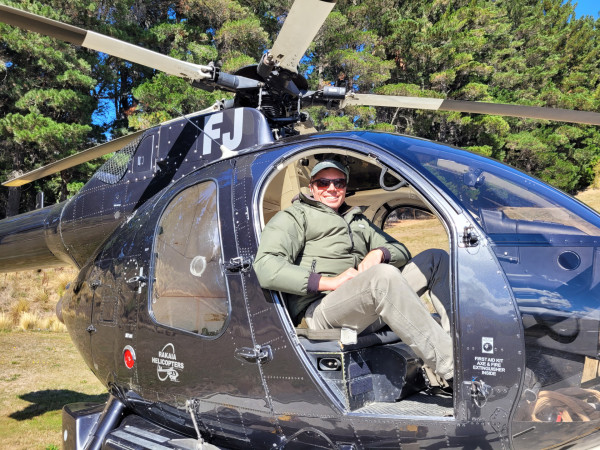
Fish & Game Officer Harry Graham-Samson about to lift off and do the first count of the Rakaia sea-run salmon spawning streams today, Harry counted 194 salmon in the streams today.
Being a short working week, this week means it's closer to another great weekend of fishing.
If you can’t get away due to other commitments, we have a great fishing opportunity close to the city with Lake Rotokohatu near Christchurch Airport.
The season dates for this fishery are from April 1st – 31st October.
With school holidays coming up, this lake provides an excellent opportunity for the family to go freshwater fishing and learn a few basic skills before venturing into other fisheries further away from Christchurch.
With only three weeks of the fishing season ending for most of our rivers and lakes.
This time of year can provide great opportunities, with the fish starting to congregate at river mouths in our high country lakes and trout becoming less spooky as their priority is to put on weight for spawning.
So, if you’ve had some frustrating days in the backcountry with spooky fish, I’d suggest that if the weather forecast is right, head up to our high country lakes and rivers.
You can make the most of it as these rivers shouldn’t have received as much fishing pressure with many anglers already packing away their fishing gear and getting ready for the game bird season or other activities.
The staff at North Canterbury are about to start the sea-run salmon spawning monitoring, where we count the salmon coming back into the spawning streams in the Rakaia and Waimakariri Rivers.
We count each catchment five times, and this gives us an indication of how many salmon have come back to spawn in the various streams.
If you haven’t seen the video on sea-run salmon monitoring stuff.co.nz did last year, you can watch it here.
2024 Rangers Competition
Celebrate the end of the sea-run salmon season with Fish & Game Staff, Honorary Rangers and fellow anglers at the 2024 Rangers Competition!
When & Where
Friday 26th April
Kairaki Beach (North side of the Waimakariri River mouth)
There are toilet facilities in the carpark area.
How to enter
No pre-registration is required; just start fishing!
If you catch a salmon, come to the weigh-in station at the Fish & Game tent by 1:00 pm to weigh it in! You must show your 23/24 season fishing licence AND your filled-in sea-run salmon licence when entering a fish (We will not accept any entries without these two licences being shown).
If you don’t have any luck on the day, you can still present your licence at the Fish & Game tent any time before 1:00 pm to go into the spot prize draw!
Fishing & Weigh-in
Fishing may commence at 5:00 am as per North Canterbury fishing regulations
Fish must be caught between the Waimakariri Mouth and the Kairaki Yacht Club at Kairaki Creek on the north side only (area highlighted in red below)
Weigh-ins from 8:00 am – 1:00 pm at the Fish & Game tent on the beach (can’t miss it!)
Prizegiving to follow at 1:30 pm
The competition will be held rain or shine!
FREE SAUSAGE SIZZLE FROM 9 am TILL FINISH
Prizes
The angler with the heaviest salmon on the day will be immortalised with their name engraved on the coveted Rangers Trophy.
We will also award the Jack Kerapa Memorial trophy for “Rangers Fisherman of the Year”.
We also have a great range of spot prizes kindly donated by North Canterbury Hunting & Fishing, Christchurch (Ballingers) Hunting & Fishing, Amazing Baits, Desolve, Hunters Element, and more!
For any further queries, please email [email protected] or call the office at (03) 366 9191.
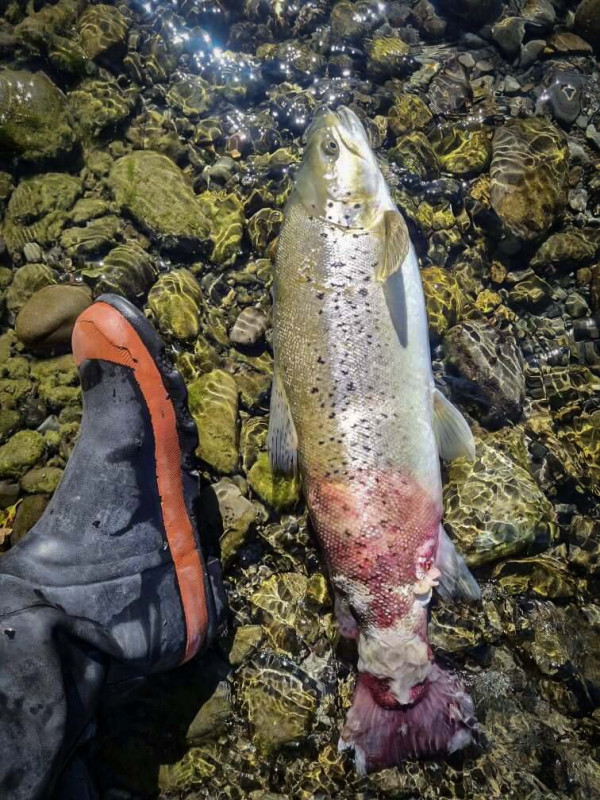
Catch and Release
A shout out to Sam Caley who spotted the fish pictured above and sent us the pictures after he spotted it swimming poorly and netted it.
The infections evident on this fish (both bacterial and fungal) is indictive of poor catch and release technique.
It is often seen when gloves are used to lift the fish out of the water for a photo.
Gloves often go straight through the protective mucus layer and (especially if they are dry) impart bacteria directly onto the fish’s skin.
This coupled with the hot temperatures we’ve had lately mean that those practising catch and release need to be extra careful that they aren’t harming the fish they are releasing.
Careful catch and release is a skill you must learn to ensure any fish you intend to release doesn’t come to harm.
Here are our ‘Quick 5’ tips for handling fish with care:
- Cool your hands and landing net by wetting them before touching the fish.
- Keep the fish in the water while removing the hook.
- Do not squeeze the fish, and never touch the gills.
- Photograph the fish in or over the water, and make it quick - the fish should not be out of the water for more than 5 seconds.
- Revive the fish facing into the current long enough for it to regain its swimming strength.
In the unfortunate instance that a fish you intended to release does end up bleeding from the gills, so long as you can legally take that fish, you should keep it as part of your bag limit and utilise it.
This YouTube video demonstrates good fish handling-skills.
Tight Lines
Harry Graham-Samson
North Canterbury Fish & Game Officer
